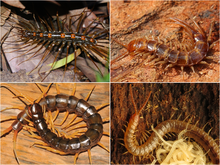
Back حريشة (مفصليات) Arabic مئويات الاقدام ARZ Chilopoda AST Dodaqayaqlılar Azerbaijani دوداقایاقلیلار AZB Lelipan BAN Губаногія Byelorussian Губаногія BE-X-OLD Стоножки Bulgarian Halilipan BJN
| Centipede | |
|---|---|

| |
| Various centipedes (clockwise from top left): Thereuopoda clunifera, a Scutigeromorph; Lithobius forficatus, a Lithobiomorph; Geophilus, a Geophilomorph; and Scolopendra cataracta, a Scolopendromorph | |
| Scientific classification | |
| Domain: | Eukaryota |
| Kingdom: | Animalia |
| Phylum: | Arthropoda |
| Subphylum: | Myriapoda |
| Class: | Chilopoda Latreille, 1817 |
| Orders and suborders | |
Centipedes (from Neo-Latin centi-, "hundred", and Latin pes, pedis, "foot") are predatory arthropods belonging to the class Chilopoda (Ancient Greek χεῖλος, kheilos, "lip", and Neo-Latin suffix -poda, "foot", describing the forcipules) of the subphylum Myriapoda, an arthropod group which includes millipedes and other multi-legged animals. Centipedes are elongated segmented (metameric) creatures with one pair of legs per body segment. All centipedes are venomous and can inflict painful stings, injecting their venom through pincer-like appendages known as forcipules or toxicognaths, which are actually modified legs instead of fangs. Despite the name, no centipede has exactly 100 pairs of legs; the number of pairs of legs is an odd number that ranges from 15 pairs to 191 pairs.[1]
Centipedes are predominantly generalist carnivorous, hunting for a variety of prey items that can be overpowered. They have a wide geographical range, which can be found in terrestrial habitats from tropical rainforests to deserts. Within these habitats, centipedes require a moist microhabitat because they lack the waxy cuticle of insects and arachnids, therefore causing them to rapidly lose water. Accordingly, they avoid direct sunlight by staying under cover or by being active at night.
© MMXXIII Rich X Search. We shall prevail. All rights reserved. Rich X Search